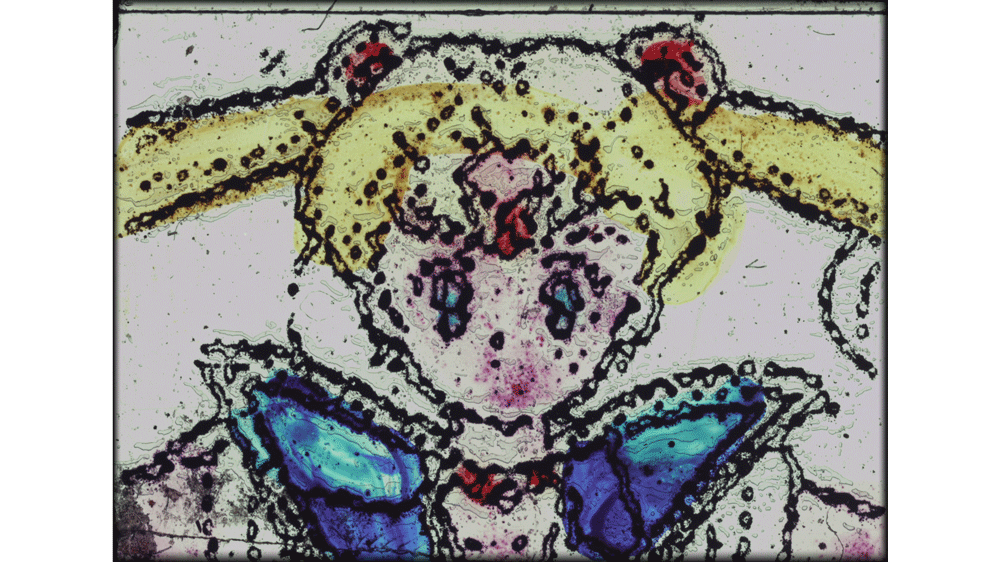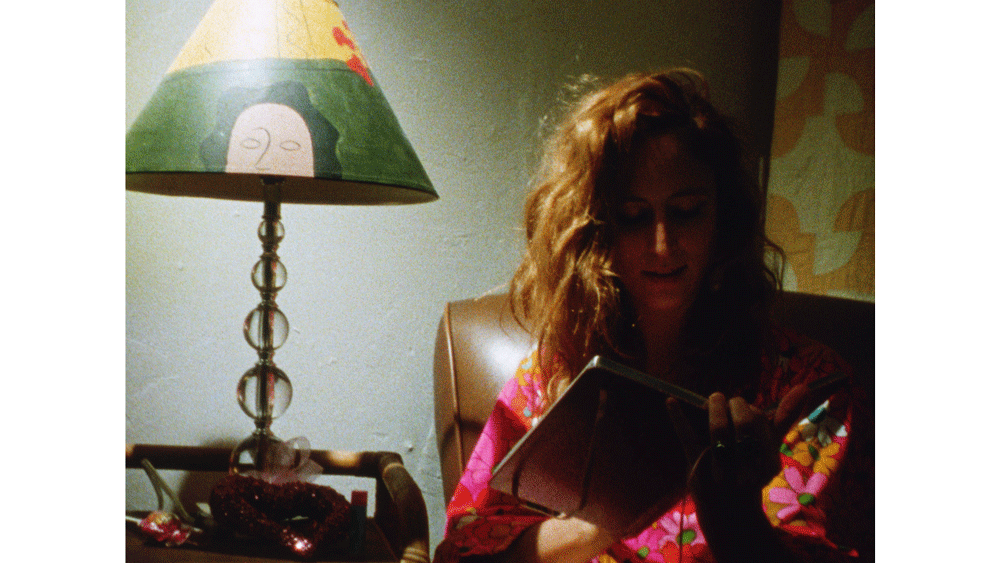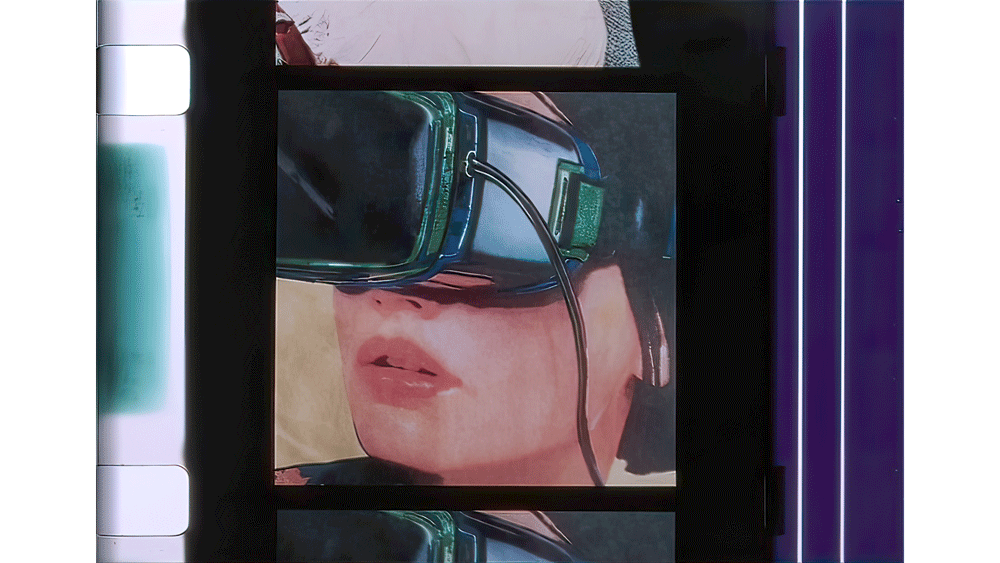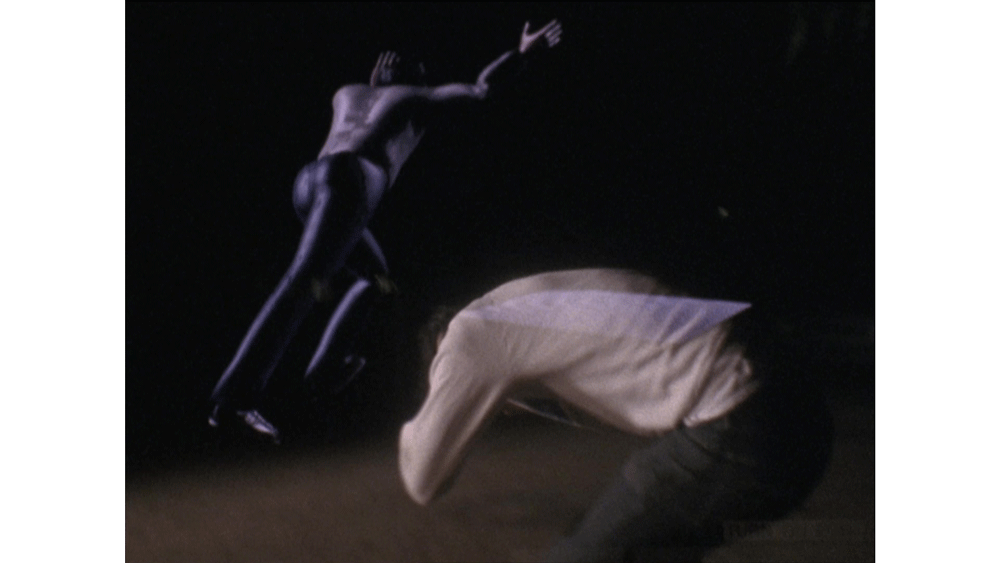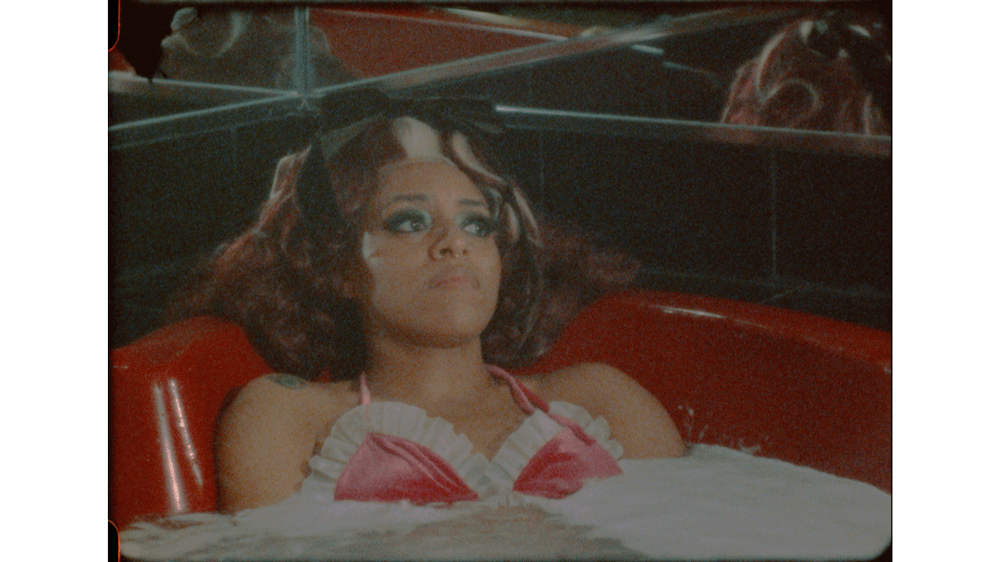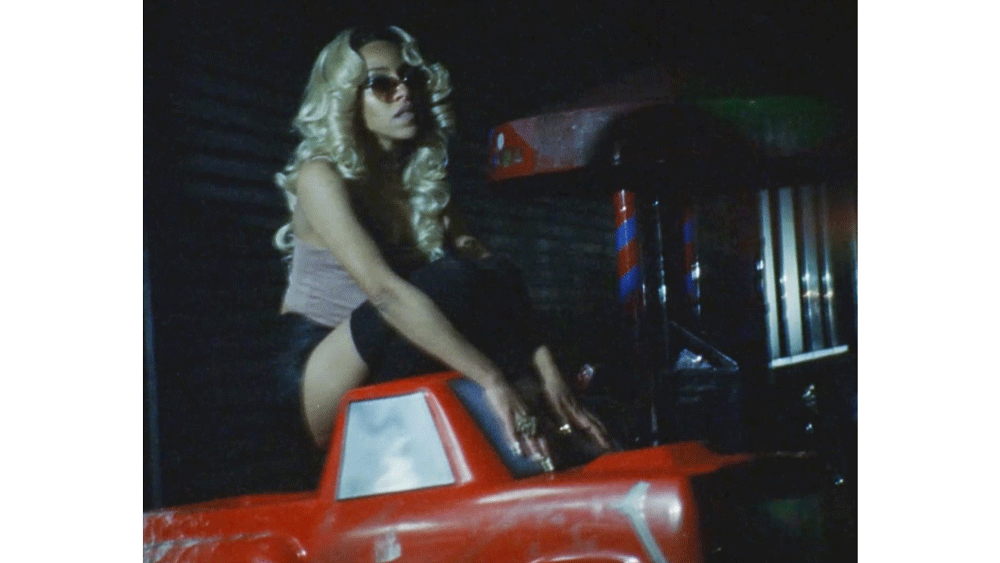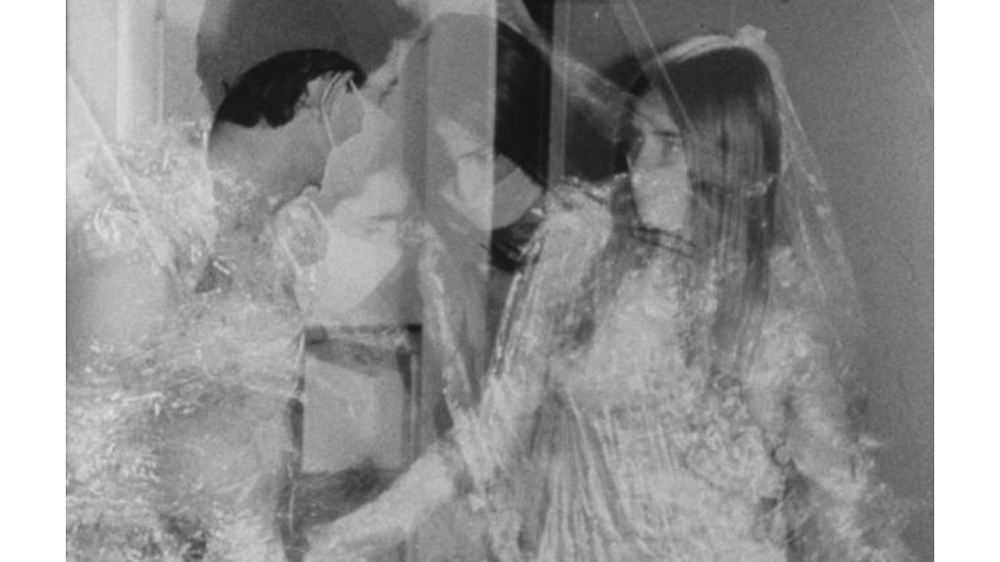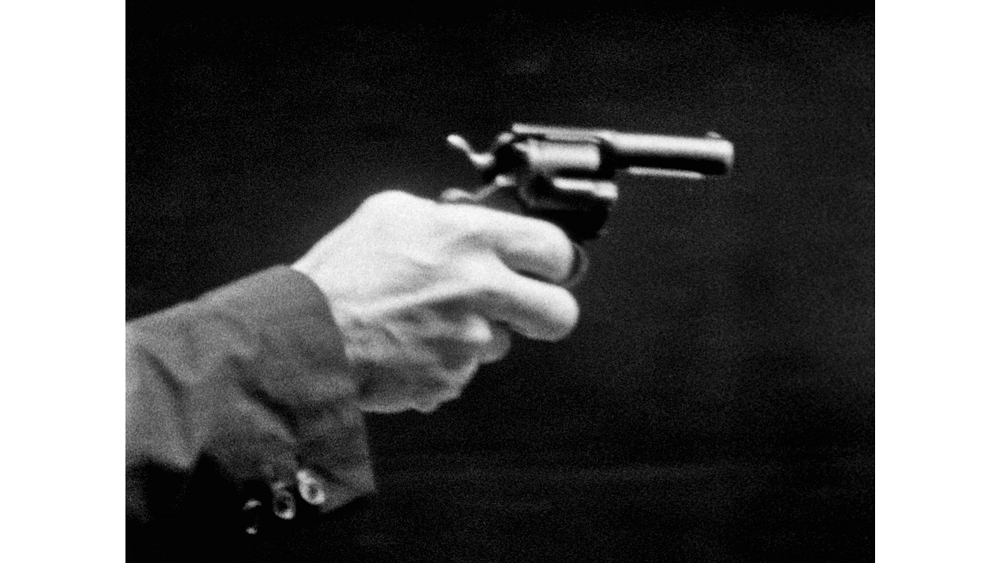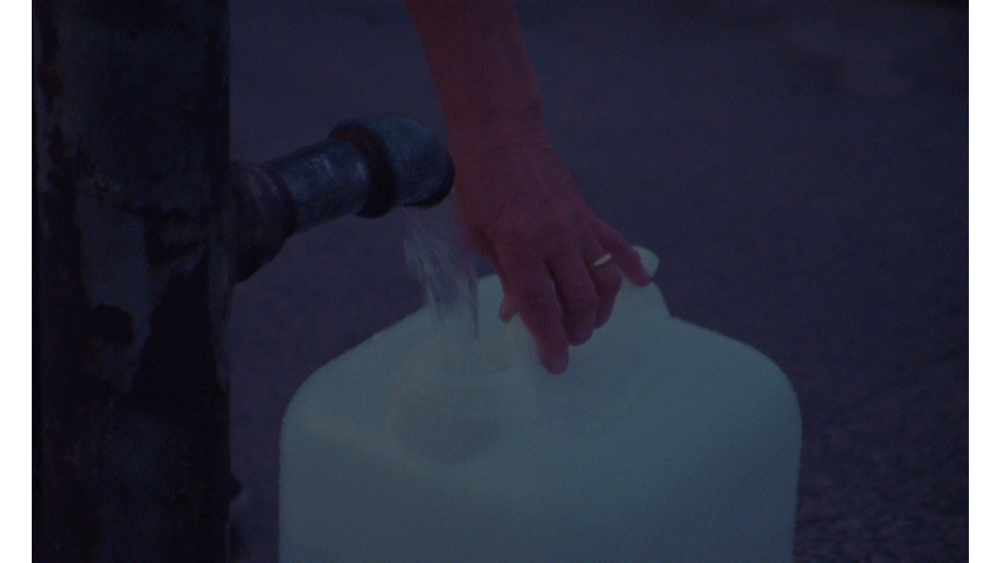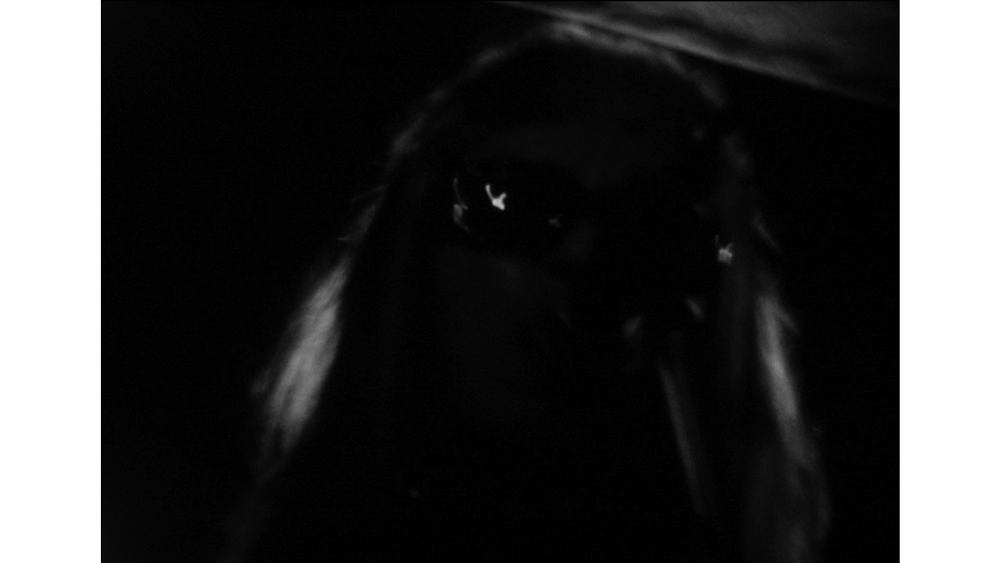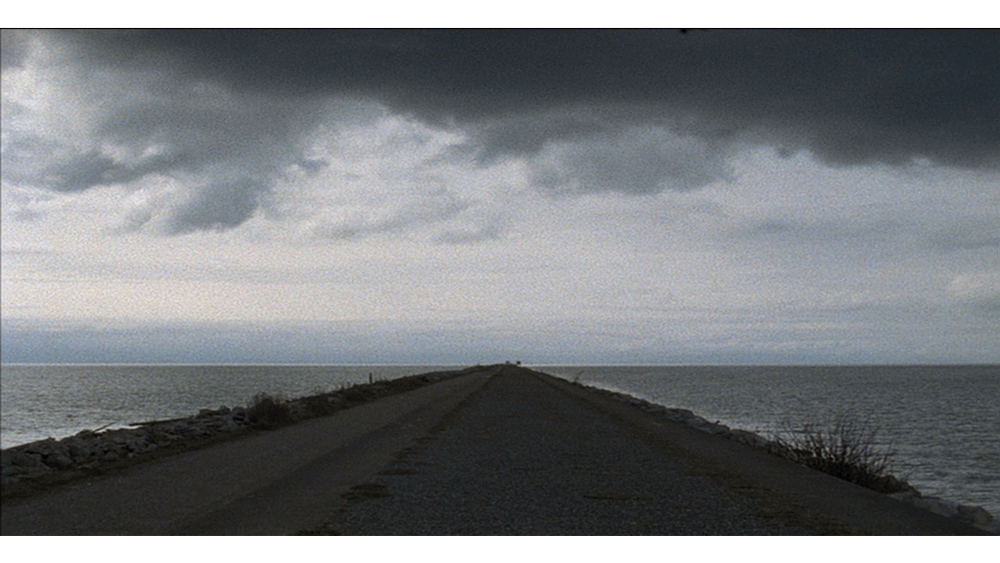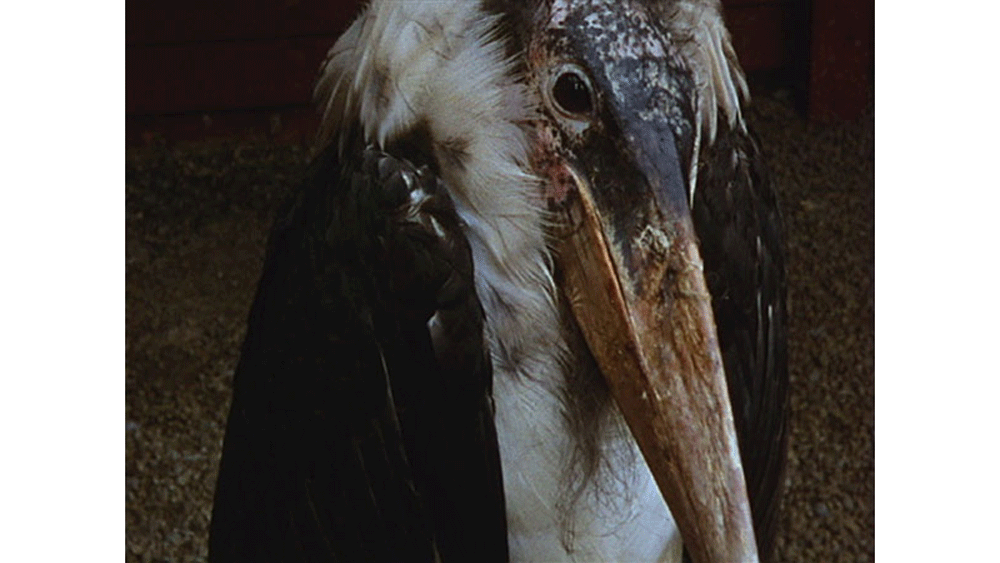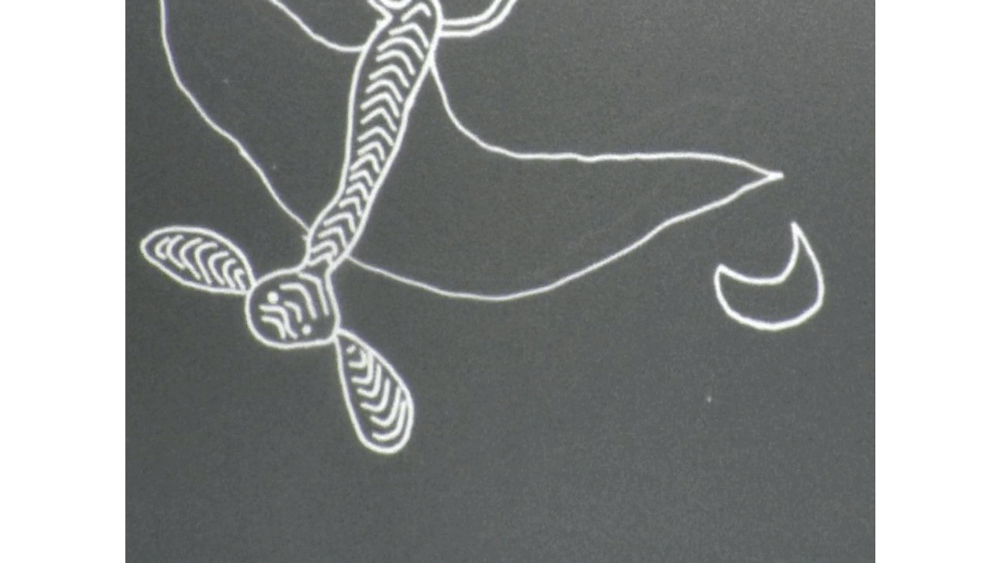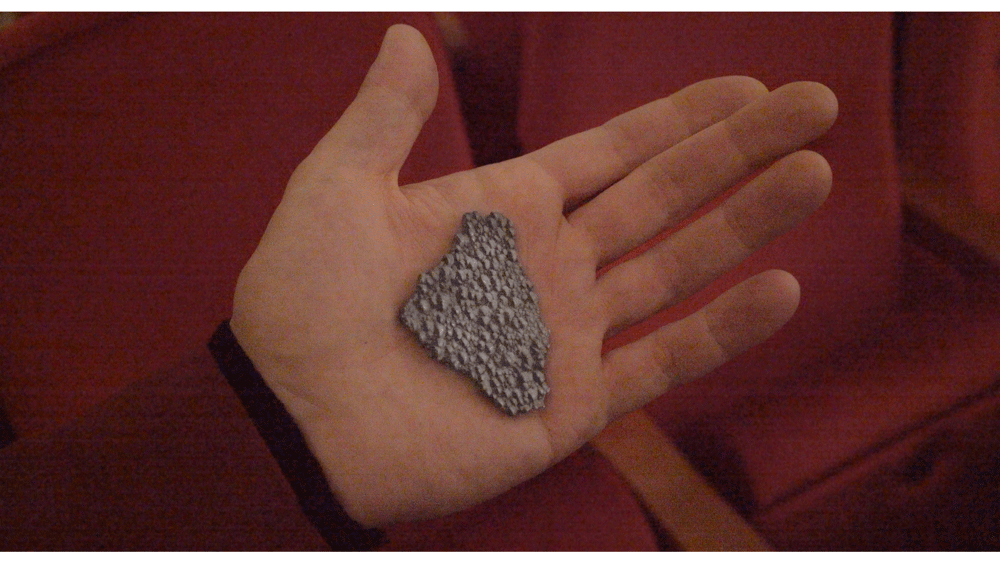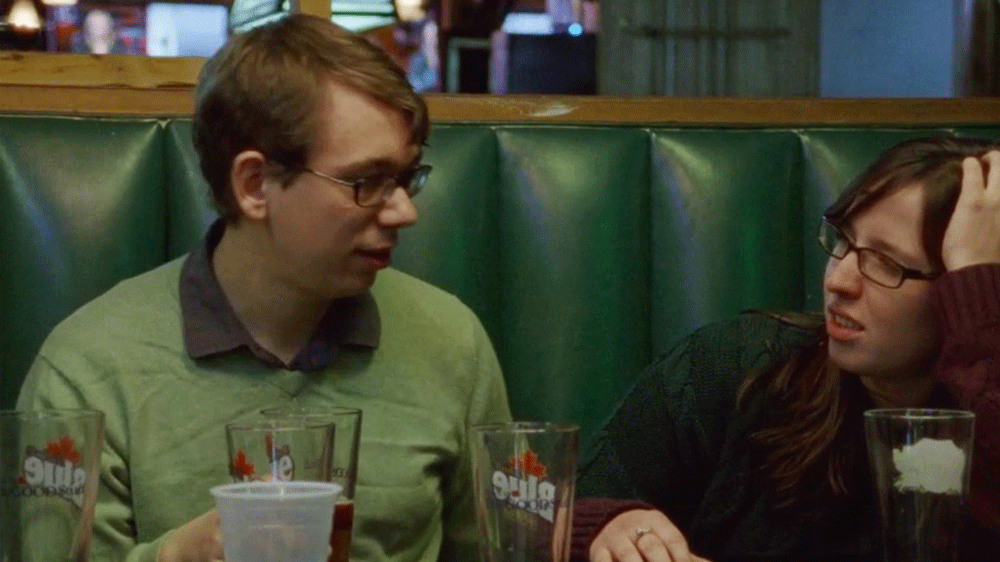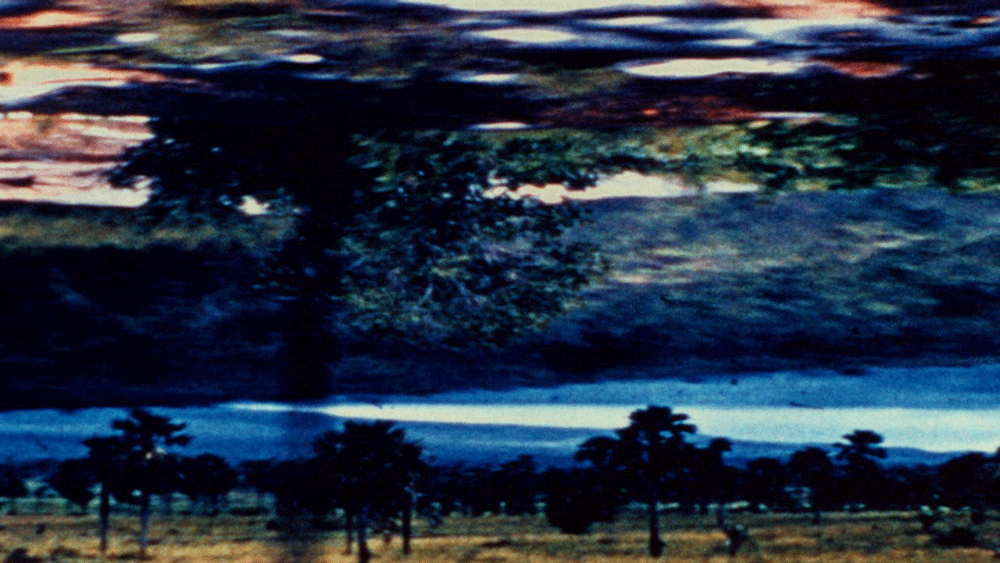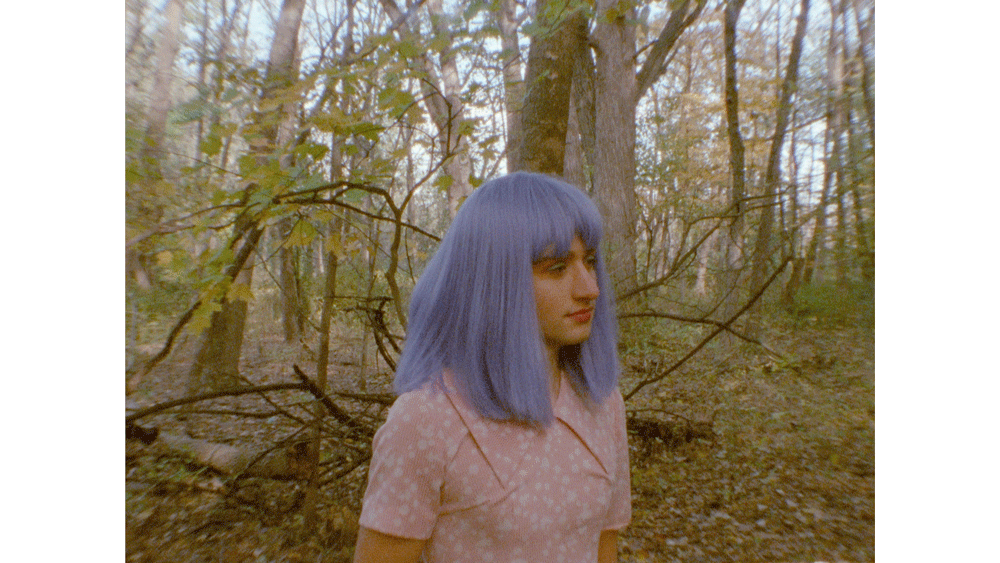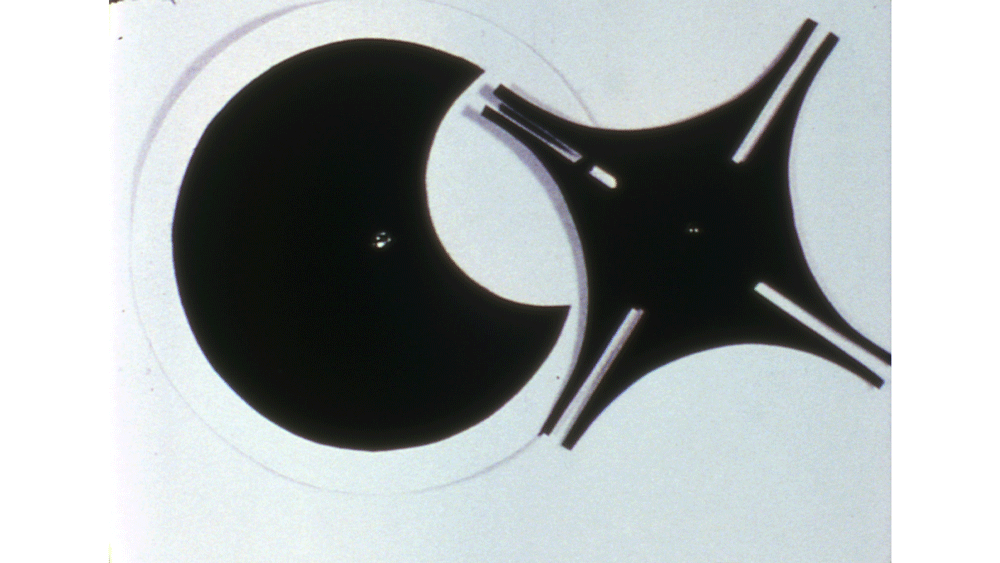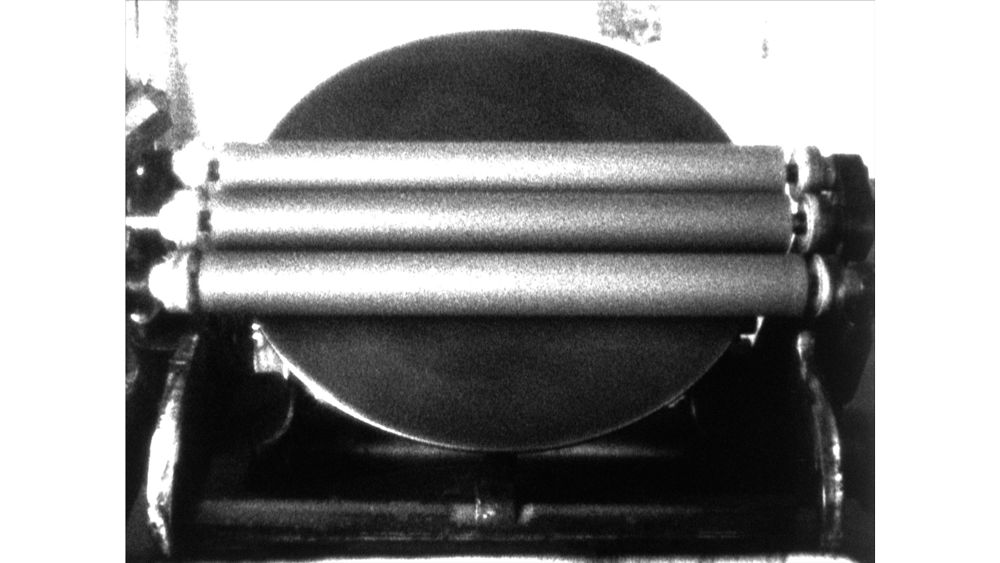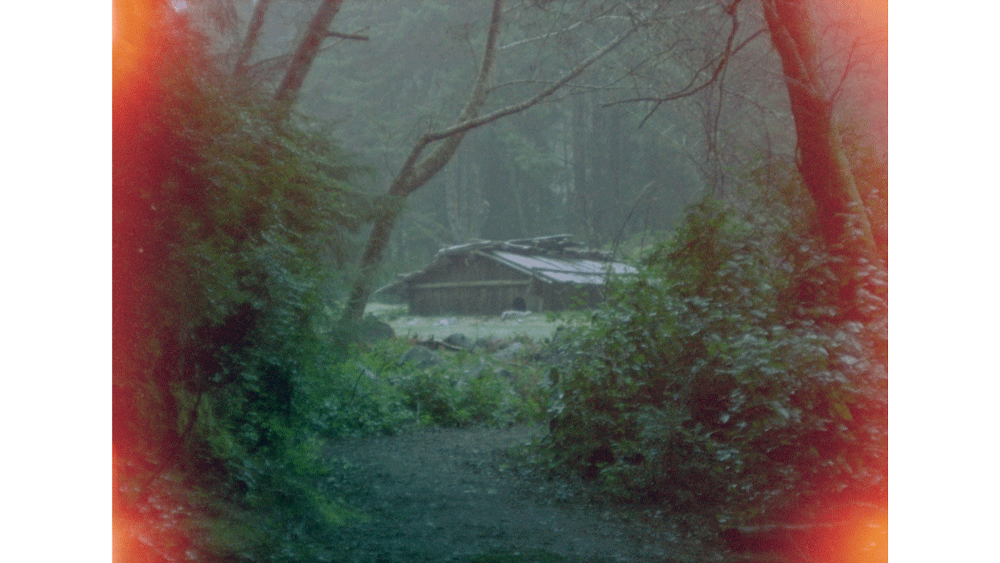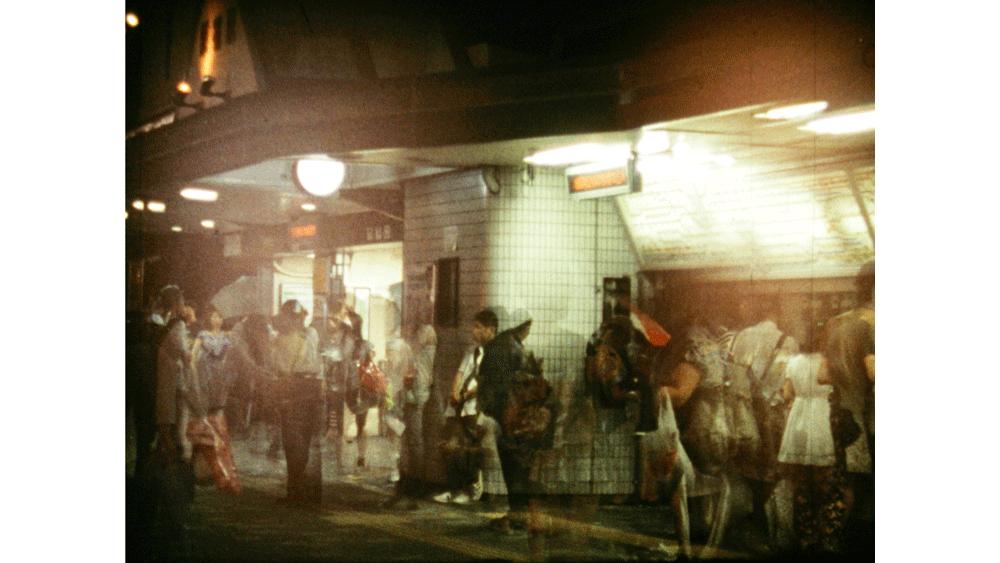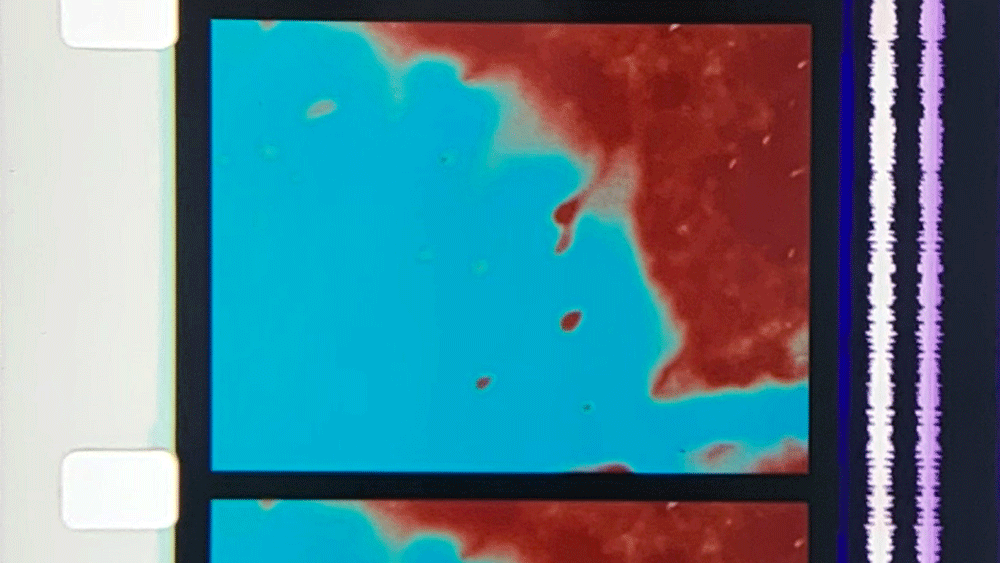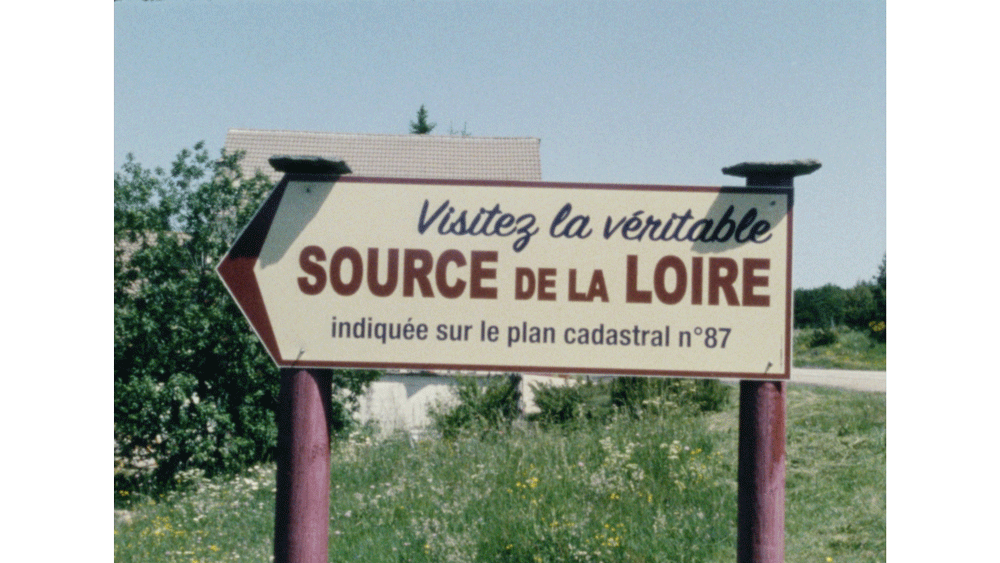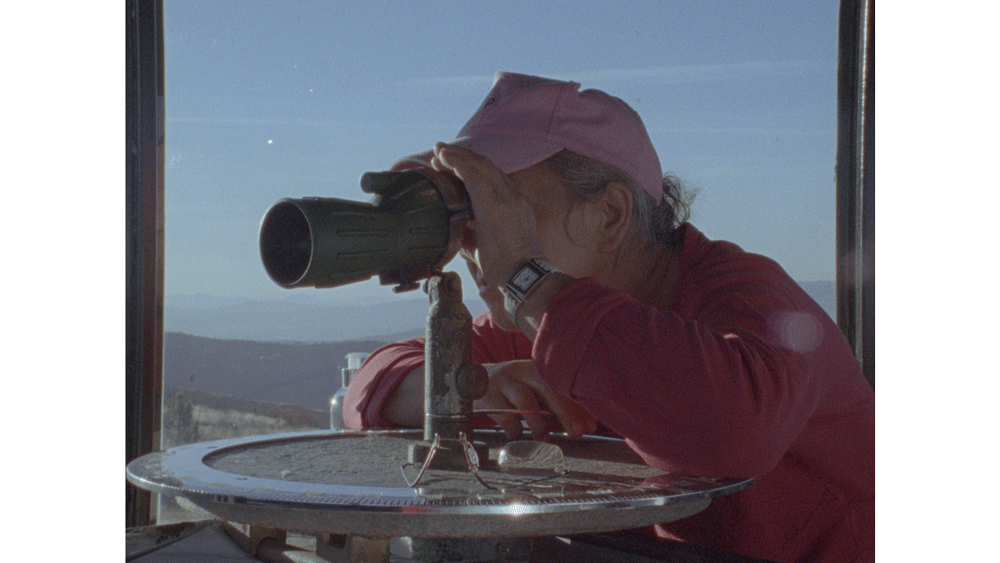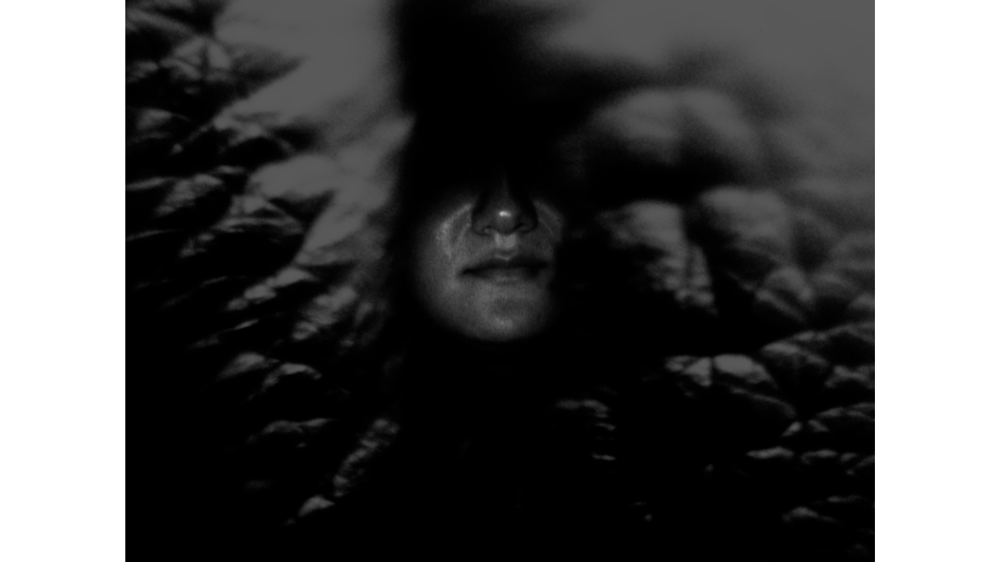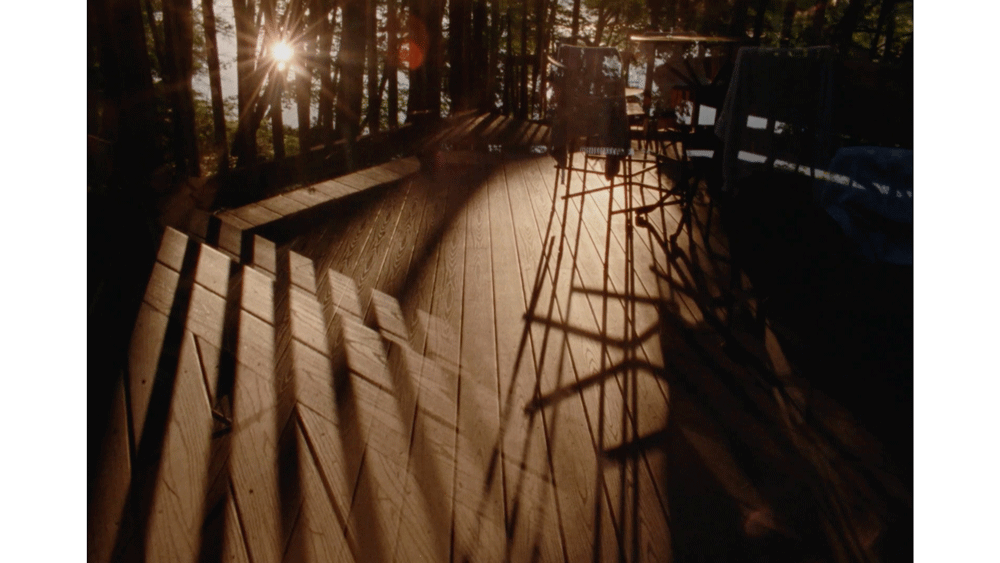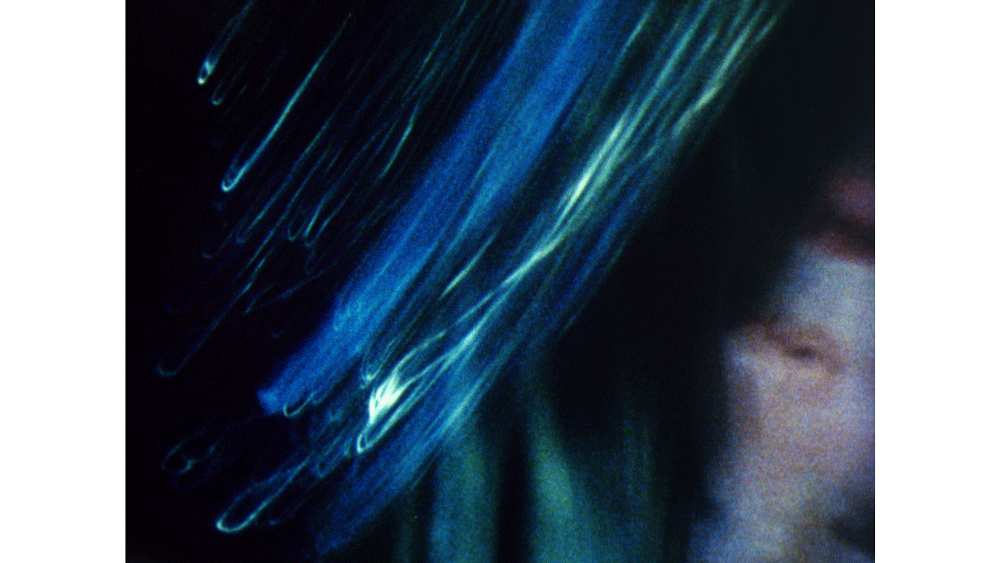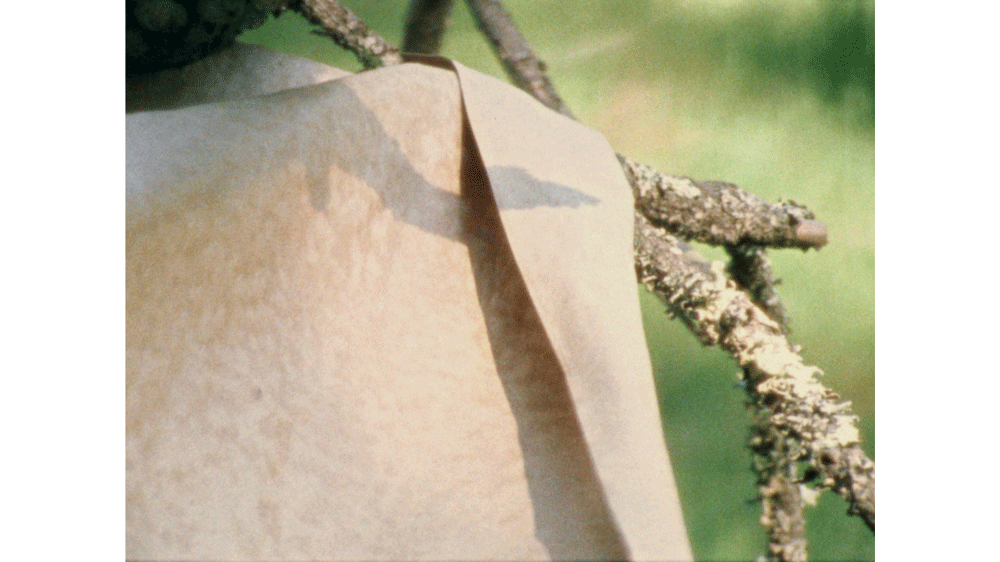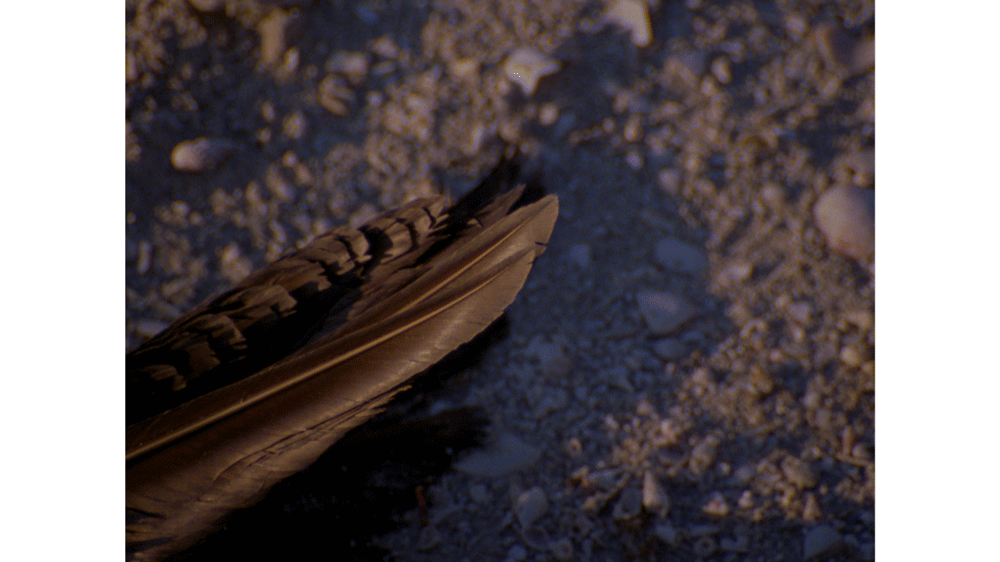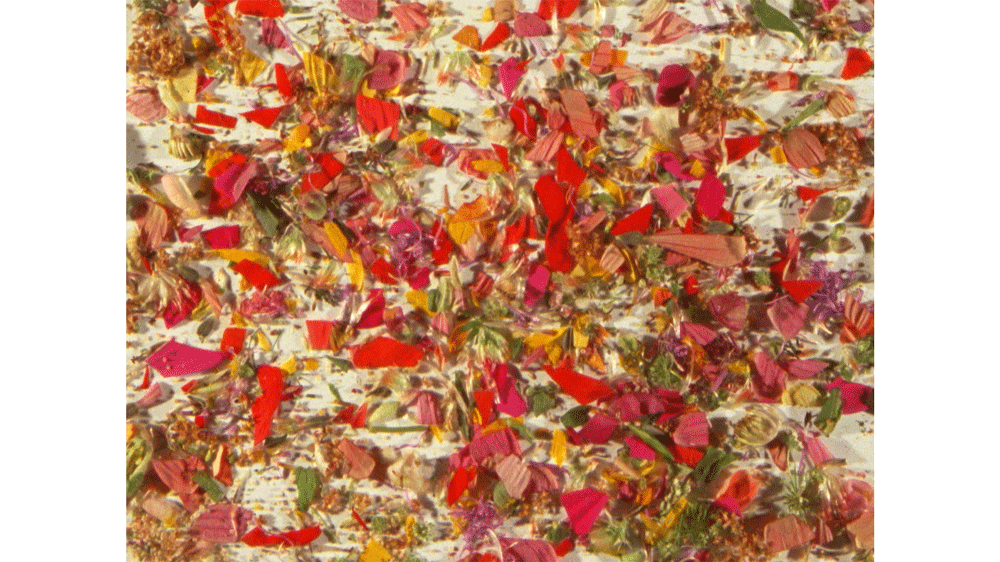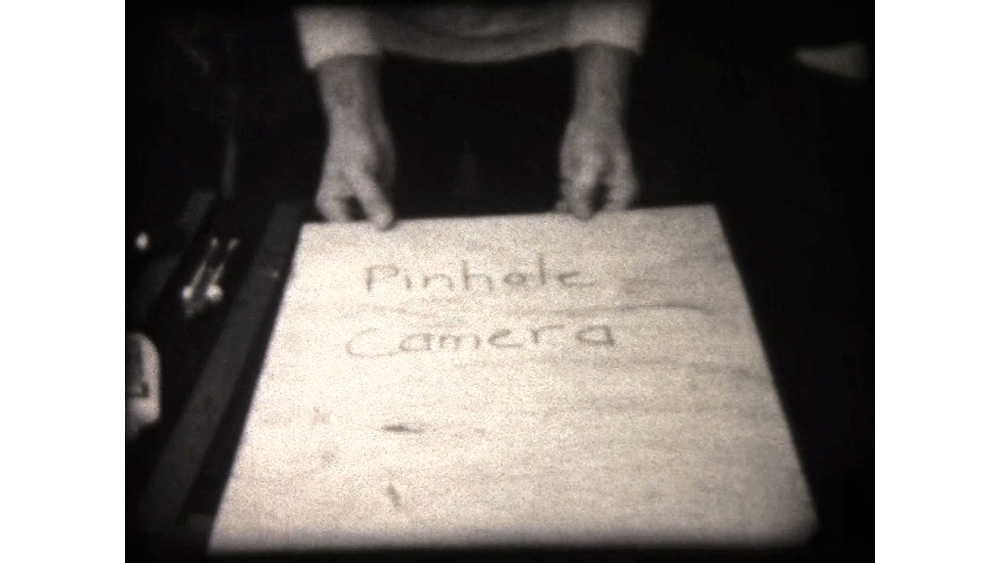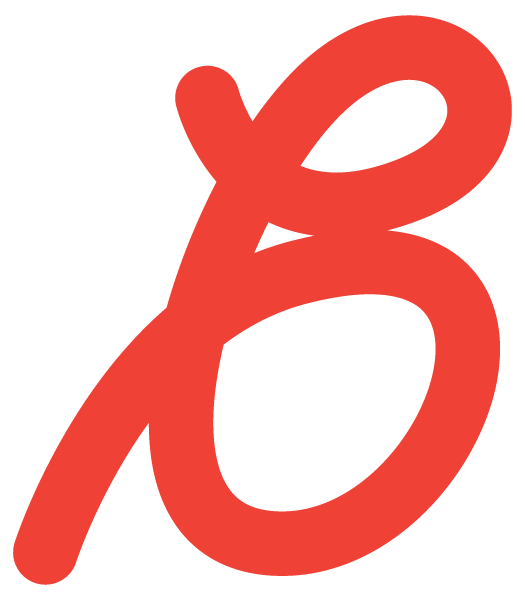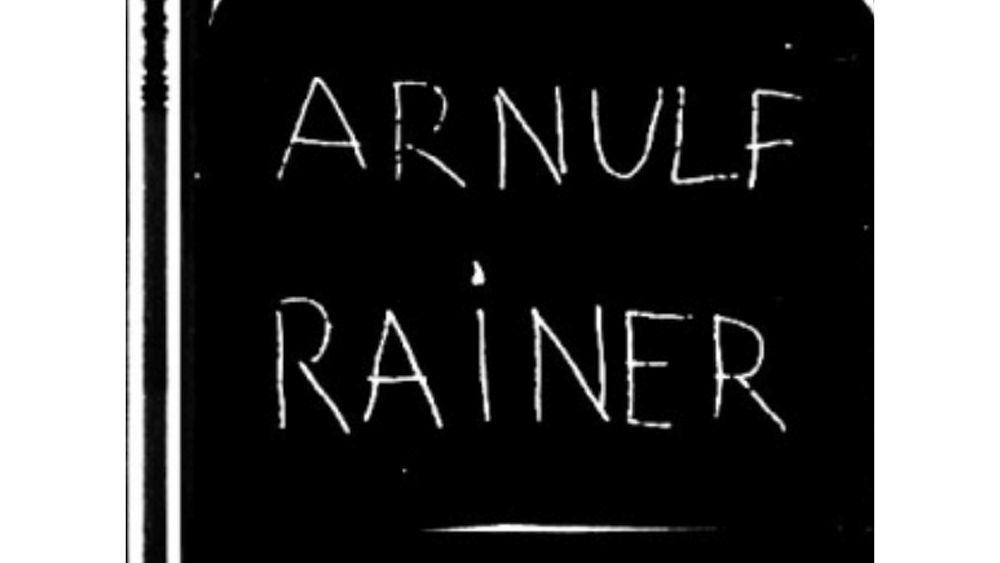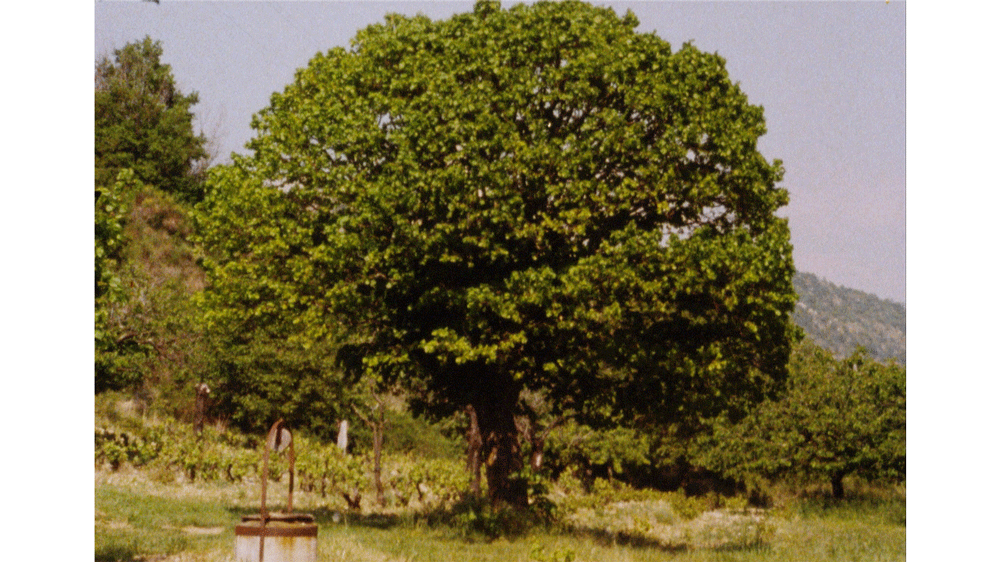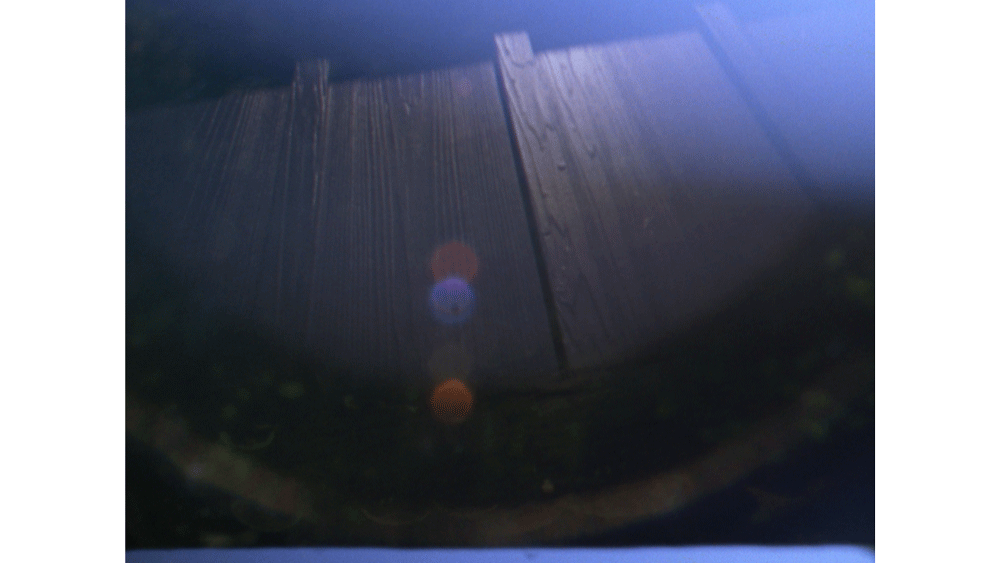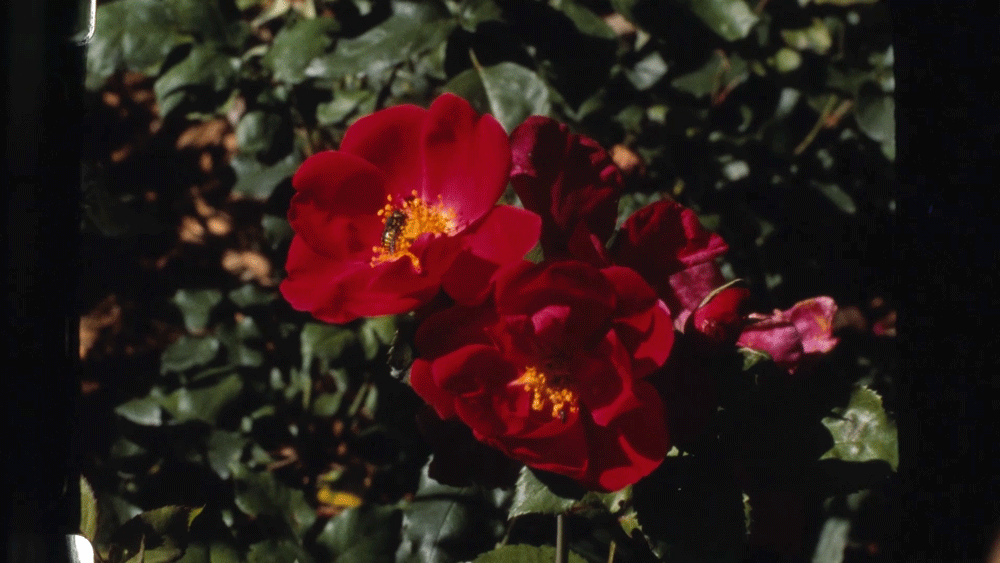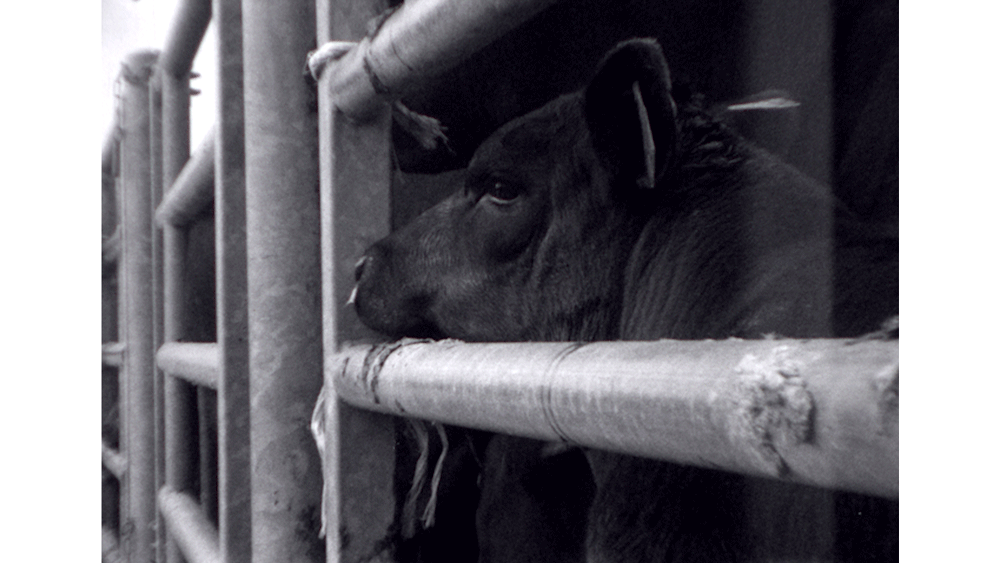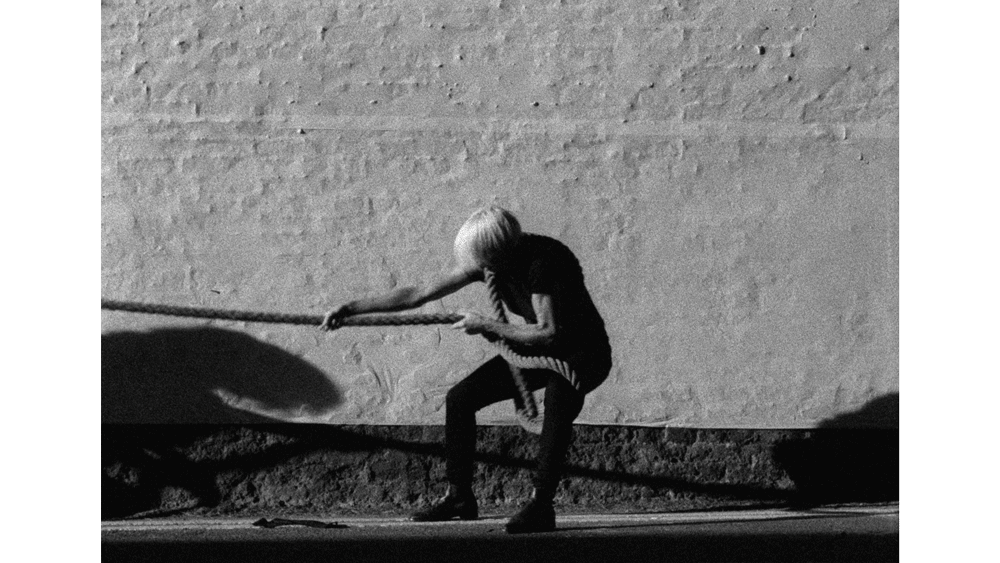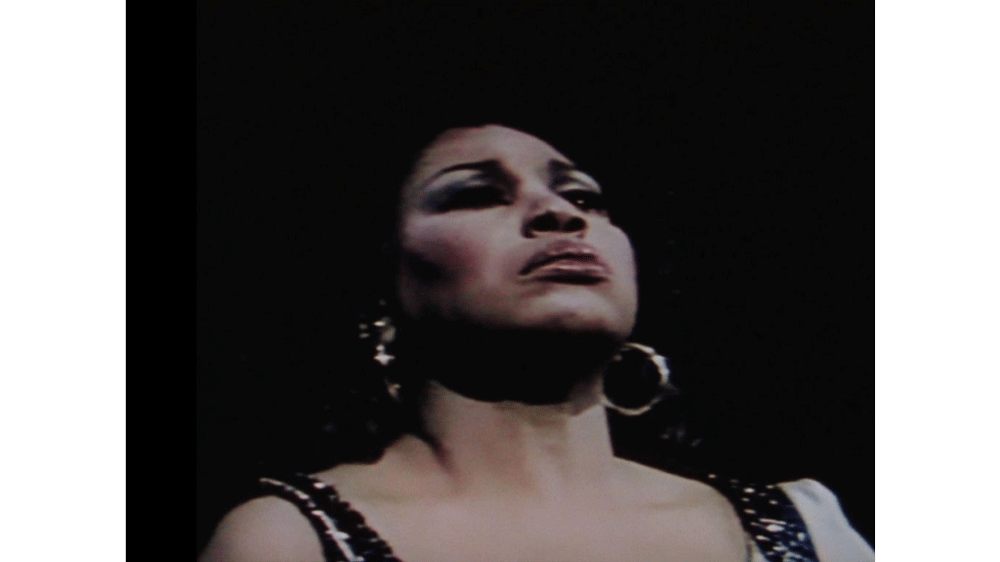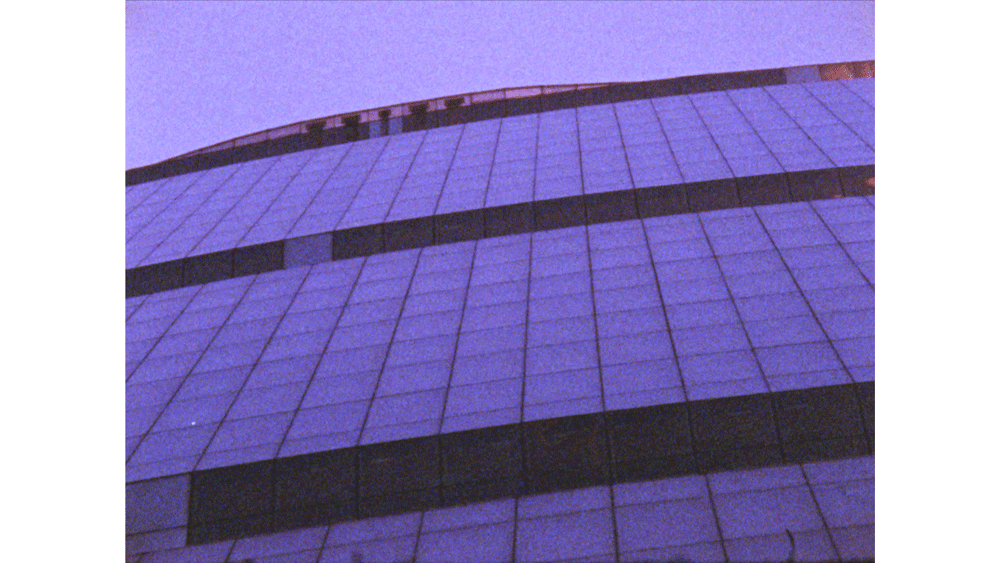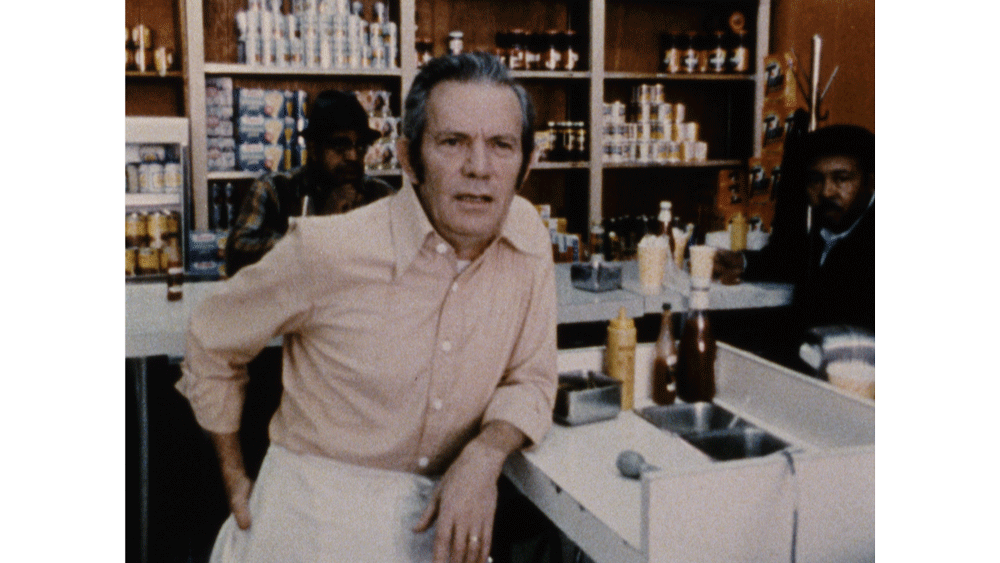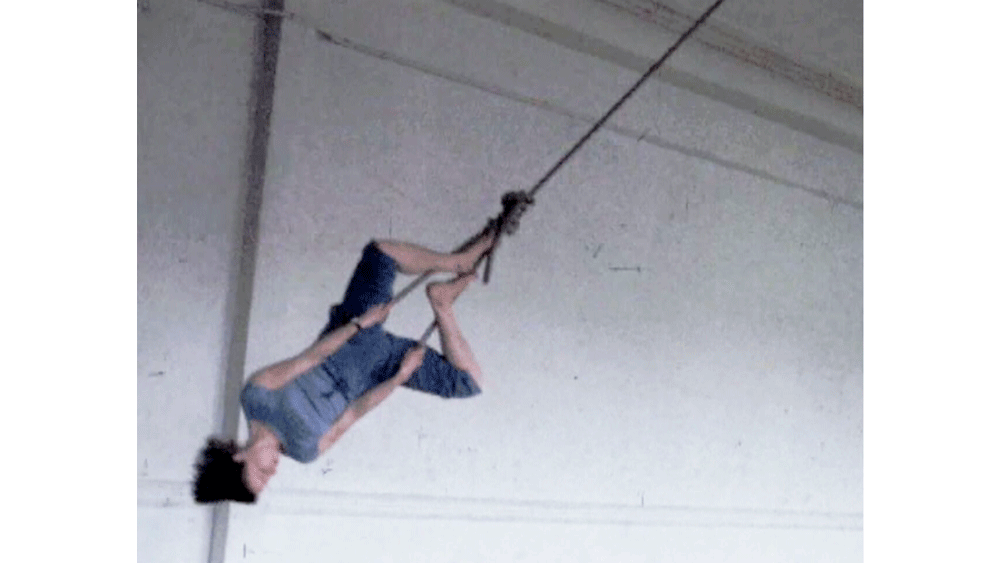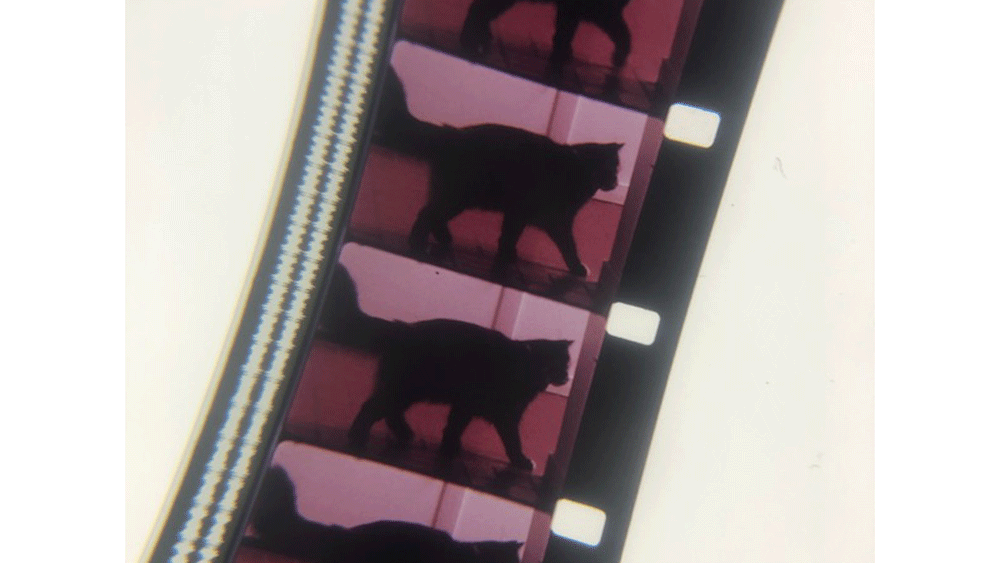The Chicago Film Society is proud to welcome you to a second edition of Celluloid Now: four days of screenings, workshops, and other events showcasing the work of analog filmmakers and artists, alongside archival rediscoveries and restorations.
Jump to a day on the schedule:
Tue 9/19 – Sun 10/22
at Buddy in the Chicago Cultural Center
78 E Washington St
To Discipline a Rock (2023, Jiayi Chen)
16mm looping installation
Chicago-based artist and filmmaker Jiayi Chen’s new looping installation To Discipline a Rock was filmed on unsplit 8mm film (the same width of 16mm) in two layers. The first of these was shot with an 8mm camera and observes a collection of rocks in a series of static compositions. The same roll was subsequently run again through a 16mm camera to capture a series of choreographies for the hand. Processed at home using developers mixed by the artist herself, the film features an additional, third layer of motion courtesy of a series of unpredictable chemical interactions within the film’s emulsion. In less than a minute, To Discipline a Rock provides all the kinetic thrills and filmmaking bravada you could ask for from action cinema.
Accessibility: All Celluloid Now locations are wheelchair accessible. Please contact us for more information about building accessibility or refer to individual venue websites:
• Chicago Cultural Center
• Constellation
• Gene Siskel Film Center
Accessibility questions? Email Rebecca at rlyon@chicagofilmsociety.org
THURSDAY 9/21
8:00 PM
Program 1 — Film Party
Constellation
3111 N Western Ave
Tickets: $15 at the door or in advance
The films in this program will be projected in 16mm.
Part 1:
Moon Cycle (I: bran stakhage’s moonlight; II: mercury retrograde) (2023, Justine Lai, 1 min.)
It Was A Good Day (2022, Christopher Carver, 2 min.)
With The Tide, with the tide (2022, Anna Kipervaser, 3 min.)
Frame of Mind (2022, Kevin Roy, 2 min.)
Mobile Phone Studies Nos. 1-25 (2020, Barron Sherer, 5 min.)
Skip Jumbo (2016, Jorge Ravelo, 2 min.)
A Picture for Parco (2022, Ayanna Dozier, 3 min.)
lovertits (2022, Ayanna Dozier, 4 min.)
an exercise in parting (2022, Ayanna Dozier, 4 min.)
Plastic Blag (1970, Judith Wardwell, 7 min.)
GUN (2016, Mary Billyou, 3 min.)
HAT (2016, Mary Billyou, 3 min.)
¡PíFIES! (2016, Ignacio Tamarit, 4 min.)
Pump (2022, Charles Cadkin, 5 min.)
===== INTERMISSION =====
Part 2:
One Roll in the Blackness (2011, Chris Kennedy, 3 min.)
Centre of the Cyclone (2015, Heather Trawick, 18 min.)
Ray’s Birds (2010, Deborah Stratman, 7 min.)
ascensions (2017-2020, arc, 8 min.)
Dude Asending a Staircase (year unknown, Michael Walsh, 3 min.)
The Bats (1999, Jim Trainor, 8 min.)
Runtime: Approx. 120 minutes plus an intermission.
2023 not only marks the return of Celluloid Now, but also the centennial of 16mm motion picture film, preferred gauge for independent / underground / experimental filmmakers the world over. In our book, that’s plenty of reason to be feeling festive, so we’re kicking things off with a two-part, jumbo-sized Film Party featuring some of our favorite recent 16mm work, along with a couple of 20th century subterranean classics we thought you might like.
For the first half of this program, we elevate your heart rate with visual elation, presenting some on-screen deviance with this selection of frenetic, miniature wonders, nearly all under 200 feet in length. We’ll start by flushing your eyes with hand-drawn Sailor Moon, heart-shaped tubs, a quest for water, impassioned hardboiled egg eating, and of course, a love letter to 16mm. The second half of the program barrels on: from a micro-concert movie, a mere 100 feet long, documenting part of a raucous, squalling performance by experimental music icon Keiji Haino, to methodically printed abstractions courtesy of Michael Walsh and arc, from a supremely beautiful landscape study that’s only occasionally interrupted by demolition derby footage to a dizzying look at a chaotic DIY aviary, and capping it all off with the greatest cartoon ever made about bats shitting and having sex. Film party tonight!
Plastic Blag was preserved by the University of California, Berkeley Art Museum and Pacific Film Archive with support from the National Film Preservation Foundation.
FRIDAY 9/22
7:00 PM
Program 2 — 35mm: Only In Theaters
Gene Siskel Film Center
164 N State St
Tickets: $13 at the door or in advance
The films in this program will be projected in 35mm.
Part 1:
Ruptures in the Reel (2022, Peter Miller, 13 min.)
In Littleness (2022, Cherlyn Hsing-Hsin Liu, 8 min.)
Color Me (2022, Robert C. Banks, 9 min.)
Going Out (2015, Ted Fendt, 8 min.)
Engram of Returning (2015, Daïchi Saïto, 19 min.)
==== INTERMISSION ====
Part 2:
Transcript (2019, Erica Sheu, 3 min.)
The Orange Velvet Dream House (2022, Nolan Barry, 18 min.)
※ This print was commissioned by CFS expressly for Celluloid Now.
III. (2022, Alexandre Larose, 13 min.)
Digital Devil Saga (2023, Cameron Worden, 11 min.)
^^ work in progress ^^
Runtime: Approx. 120 minutes plus an intermission
For the majority of the last 100 years, independent film artists have usually deferred to making and screening films on small gauges like 16mm or super 8 rather than the standard theatrical gauge, 35mm. Small gauge stock and lab costs have generally been cheaper, the cameras are lighter, and the projectors are often portable, making it possible for screenings to happen outside of traditional commercial cinemas, where low-budget personal films are usually shunned as revenue-torching anomalies. Things look different in 2023. Filmmakers are collectively pooling resources to start their own artist-run film labs where they can manufacture DIY exhibition prints for the cost of materials. This has facilitated works like Alexandre Larose’s III., which through entirely photochemical means brings together super 8, 16mm, and 35mm footage in a series of precisely layered and indescribably beautiful compositions. Meanwhile, traditional film labs have begun offering to strike one-off 35mm exhibition prints direct from video files for less than half the price it would cost to do the same thing in 16mm, an innovation that has opened analog exhibition to a huge range of young upstarts. Nearly half the films in this program were printed using this method.
Despite this uptick in new, self-financed 35mm prints from independent artists, it remains difficult for most people, including the artists themselves, to actually see these films projected on 35mm. Case in point: at least a third of the films featured in this program will be screening publicly on 35mm for the first time ever. To make sure you get your fill of these deluxe-sized prints, we’re hosting a two-part, deluxe-sized screening. Featuring a cinematic drag pageant-cum-mystical ceremony, an experimental approach to CinemaScope spectacle, a minor-key comedy suffused with all the joy and torment of visiting a suburban multiplex with your adult friends, and at least two films made by former Gene Siskel Film Center staff projectionists.
SATURDAY 9/23
noon
Program 3 — Light Signals
Chicago Cultural Center
78 E Washington St
in the Claudia Cassidy Theater (2nd floor)
FREE ADMISSION
The films in this program will be projected in 16mm.
The Maltese Cross Movement (1967, Keewatin Dewdney, 8 min.)
For Bucky Fuller (2019, Kioto Aoki, 3 min.)
Light Signal (2022, Emily Chao, 11 min.)
Shibuya – Tokyo (2010, Tomonari Nishikawa, 10 min.)
P L U M E (2022, Mike Rollo, 8 min.)
La Source de La Loire (2021, Rose Lowder, 19 min.)
Runtime: Approx. 60 minutes
In projection land, the Maltese cross is the mechanism that converts the continuous motion of a spinning motor into the discontinuous motion required to pause each film frame momentarily in the projector gate, something that’s necessary for a projected motion picture image to look correct. You’ll find no shortage of little engineering marvels like this inside any given film projector or camera, a series of ingeniously conceived mechanisms working together to create an incomparable form of magic for the senses. Projectionists and filmmakers alike love their machines, perhaps even more so since the broader implementation of digital video has decimated so much of the manufacturing and technical service infrastructure necessary to keep artists shooting film, and venues projecting it. This program begins with a film by avant-garde computer scientist Keewatin Dewdney, who made a half dozen 16mm shorts during his time as a mathematics PhD student and for whom the Maltese cross was the rosetta stone for understanding the hidden language of moving images. (Dewdney has admitted to experimenting with LSD during his filmmaking days.) Each of the five contemporary works that follow elaborates on some aspect of the film mechanism: reality-distorting photochemistry; in-camera experiments with collapsing linear time; and the semiotic transformation of light as it moves through the camera lens onto a film strip and subsequently from a projector lamphouse, through the film strip once more, and onto the screen.
SATURDAY 9/23
1:30 PM
Program 4 — The Forest for the Trees
Chicago Cultural Center
78 E Washington St
in the Claudia Cassidy Theater (2nd floor)
FREE ADMISSION
The films in this program will be projected in 16mm.
Extended Presences (2023, Margaux Dauby, 12 min.)
Only If You Could See a View Above the Clouds (2022, Zhuoyun (Yun) Chen, 4 min.)
Light’s Return (2021, Kathleen Rugh, 3 min.)
This Must Be the Wood (2017, Anna Hogg, 8 min.)
Witch’s Butter (2022, Miriam Campos-Quinn, 3 min.)
Next Her Heart (2023, Anna Kipervaser, 12 min.)
M*U*S*H (2022, Jodie Mack, 8 min.)
Runtime: Approx. 60 minutes
Few greater optical pleasures exist in film than well-captured natural light, a singular photochemical phenomenon impressed on the emulsion by the cosmic rays of the sun. These same energy waves nourish the sylvan specimens found across the films in this program. Just as earth’s flora basks in the sun’s light, we’re sure you will enjoy these films, all of which look outside of cloistered, human-dominated experience toward the world of plants, mushrooms, elements, and decay. The women who staff the fire watch towers in Extended Presences, the program’s first film, provide a convenient example for modeling viewing: attentive, relaxed, disinterested, or some combination as the situation dictates. The approaches to natural observation the rest of these filmmakers take range from extra-cinematographic abstractions like the processing experiments found in Only If You Could See a View Above the Clouds and the pulsating flicker animation of M*U*S*H, to the beguiling narrative experiment This Must Be the Woods, to the mysterious symbolist tableaus of Next Her Heart. All brought to you by our remarkable sun, beloved by plants and filmmakers alike.
SATURDAY 9/23
6:00 PM
Program 5 — Casual Cinema
Chicago Cultural Center
78 E Washington St
at Buddy (1st floor)
FREE ADMISSION
Join us from 5:00 PM – 8:00 PM at Buddy inside the Chicago Cultural Center for a free reception. In conjunction with Celluloid Now, Buddy will also be hosting Jiayi Chen’s looping 16mm installation To Discipline a Rock from September 19th through October 22nd.
The films in this program will be projected in Super 8.
Fluxus of things (2023, Tetsuya Maruyama, 3 min.)
that this is (2023, Blanca Garcia, 3 min.)
Fuego Rápido (2022, Jimmy Schaus, 3 min.)
Pinhole Camera (2016, Sandy McLennan, 3 min.)
A contemporary knightess (2023, Luciana Lopez Schütz, 7 min.)
Runtime: Approx. 20 minutes
At the present moment, Kodak, the largest manufacturer of film in the world by an extraordinary margin, offers motion picture camera stocks in four different gauges, a range of products that illustrates how incredibly diverse and accommodating analog film tech has always been to artists: 65mm (the production counterpart to 70mm exhibition prints), 35mm, 16mm, and super 8. The beefier end of this scale is synonymous with a form of spectacle unimaginable outside of a full scale cinema, but the sveltest of these gauges is something audiences almost never have the opportunity to see projected in public. Since digital video has become the consumer moving image technology of choice, super 8 has been recast as a particularly intimate artist medium, shot on simple, tiny cameras accommodating to spontaneous decision-making and run on projectors no larger than a microwave. For decades, lab support for making super 8 exhibition prints has been somewhere between limited and non-existent. Any exhibition of contemporary super 8 films such as this one is inevitably going to be screening one-of-a-kind, irreplaceable reversal prints, the very same rolls of film each artist loaded into their cameras. That’s true of all five films in this tiny program, each an irreplaceable alchemical window into an artist’s vision.
SUNDAY 9/24
noon
Program 6 — Looking at Sound: An Adventure in Optical Audio Tracks
Chicago Cultural Center
78 E Washington St
in the Claudia Cassidy Theater (2nd floor)
FREE ADMISSION
The films in this program will be projected in 16mm.
Preceded by an overview of how optical sound works, including live demonstrations!
Arnulf Rainer (1960, Peter Kubelka, 7 min.)
Impromptu (1989, Rose Lowder, 8 min.)
Six Seventy-Two Variations (2021, Tomonari Nishikawa, approx. 30 min.)
Runtime: Approx. 90 minutes
For most of film’s history, the optical soundtrack has been the dominant method for adding sound to a film print. Printed a set number of frames ahead of a film’s image so that it will sync correctly, and read using a small light, lens, and a photocell, optical sound has proven an extremely durable form of technology, still functioning, remarkably, much like it did near the dawn of sound cinema. During the first half of this program, technicians from the Chicago Film Society will give an overview of how optical sound actually works, complete with demonstrations and other fun surprises.
For the second half, we’ll be presenting films by Peter Kubelka and Rose Lowder which creatively address the physical process of editing and printing optical soundtracks. We conclude the program with filmmaker Tomonari Nishikawa, joining us in person to perform his recent work Six Seventy-Two Variations which involves directly manipulating the soundtrack area on a lengthy 16mm film loop to create ever-intensifying rhythms in sound and image.
SUNDAY 9/24
3:00 PM
Program 7 — Midday Revelations & Destinations
Chicago Cultural Center
78 E Washington St
in the Claudia Cassidy Theater (2nd floor)
FREE ADMISSION
The films in this program will be projected in 16mm.
pài-la̍k ē-poo (saturday afternoon) (2020, Erica Sheu, 2 min.)
Babbler, Fairy and Thrush (2022, Karel Doing, 4 min.)
38 River Road (2016, Josh Weissbach, 7 min.)
Ultimate form #003 Garden Portraits (2020, Victoria Oliver Farner, 3 min.)
The Watershow Extravaganza (2016, Sophie Michael, 11 min.)
Transhumance (2023, Elodie Ferré,, 5 min.)
breathing (2023, arc, 11 min.)
Traction (2023, Jenny Baines, 3 min.)
oh my homeland (2019, Stephanie Barber, 4 min.)
Runtime: Approx. 60 minutes
In this all-16mm program, the solidity of the past, present, and physical worlds are jarred by memory, uncertainty, sentimentality, contradictions, and all of the other facets of life that shape, direct, and haunt us during seemingly ordinary, yet remarkable days. Where are we going and where have we been? In Erica Sheu’s emotive and moving pài-la̍k ē-poo (saturday afternoon), the earthly and spiritual worlds collide in a novel way. Karel Doing’s abstract black and white short Babbler, Fairy and Thrush depicts the plenteousness of the living world through images of nature, encroaching sounds, and shifting light. Josh Weissbach’s unsettling family drama 38 River Road stumbles through the woods and the past, seeking refuge and offering clues. In Victoria Oliver Farner’s Ultimate form #003 Garden Portraits, a vivid and colorful afternoon features a family that remains just out of reach. We head into the night with Sophie Michael’s blast to the past, The Watershow Extravaganza, where variegated colors, water, and light are superimposed during a retro British watershow. Heading towards the unknown, Elodie Ferré’s Transhumance is a black and white, overexposed depiction of cattle moving cluelessly towards their next destination. In arc’s intense, consuming breathing, the environment is removed and an authoritative voice drives the viewer towards knowledge or destruction. Jenny Baines’ Traction features a battle with an unseen adversary: a game of tug and rope that threatens to drag the film’s main figure out of the game. Stephanie Barber’s oh my homeland closes this program with a round of applause.
SUNDAY 9/24
5:00 PM
Program 8 — Chicago Cinema 16
Chicago Cultural Center
78 E Washington St
in the Claudia Cassidy Theater (2nd floor)
FREE ADMISSION
The films in this program will be projected in 16mm.
Reflections (1955, Madeline Tourtelot, 5 min.)
James R. Thompson Center (2018, Ellery Chalmers, 6 min.)
※ This print was commissioned by CFS expressly for Celluloid Now.
Remembrance: A Portrait Study (1967, Edward Owens, 6 min.)
Jerry’s Deli (1974, Tom Palazzolo, 9 min.)
Ellen on the Rope (1978, Jean Sousa, 6 min.)
Dream Works (1981, Tatsu Aoki, 14 min.)
Bouquet (1988, Sharon Couzin, 20 min.)
The Scratchman (1980, Heather McAdams, 3 min.)
Runtime: Approx. 90 minutes
After a whole weekend of vanguard analog cinema culled from across the globe, we close Celluloid Now with a tribute to Chicago’s own rich history of 16mm filmmaking. Nurtured in art schools like the School of the Art Institute of Chicago and in community-oriented organizations like Chicago Filmmakers and the Experimental Film Coalition, exhibited in local screening programs like the Onion City Experimental Film Festival and Aardvark, and distributed by the Midwest-focused Center Cinema Co-op, the film artists who have made Chicago their home over the last 70-odd years are responsible for a body of regional cinema that, despite lacking a comparable level of attention or acclaim, stands toe-to-toe with underground film hot beds like New York and San Francisco. It would be impossible to do justice to the enormous range of small gauge cinema Chicago has produced over the years with just a single program, so instead we’ve assembled a grab bag with local classics like Tom Palazzolo’s Jerry’s Deli, internationally acclaimed work like Jean Sousa’s Ellen on the Rope, and overlooked, rarely screened triumphs by scene veterans like Tatsu Aoki’s Dream Works and Sharon Couzin’s Bouquet. Additionally, we’ve struck a brand new print of Ellery Chalmers’s James R. Thompson Center, which will be screening on film for the first time ever. Finally, this program highlights films preserved by two local organizations dedicated to safeguarding Chicago’s rich film legacy: Madeline Tourtelot’s foundational work of abstraction Reflections, which screens courtesy of the Chicago Film Archives, and the Chicago Film Society’s own preservations of two essential local works: Edward Owens’s Remembrance: A Portrait Study and Heather McAdams’ The Scratchman.
Reflections was preserved by Chicago Film Archives and The Flaherty.
Remembrance: A Portrait Study was restored by the Chicago Film Society, The New American Cinema Group, Inc./The Film-Makers’ Cooperative, and the John M. Flaxman Library at the School of the Art Institute of Chicago, with the support of the National Film Preservation Foundation’s Avant-Garde Masters Grant Program and the Film Foundation. Funding provided by the Hobson/Lucas Family Foundation.
The Scratchman was restored by the Chicago Film Society with funding from the National Film Preservation Foundation.
PROGRAM NOTES
In 2019, the Chicago Film Society began actively keeping track of what we referred to internally as “working analog filmmakers.” More specifically, we began maintaining a log of people we ran across who were actively making and exhibiting films independently on analog motion picture film stock via film festivals, universities, micro-cinemas, and other venues outside the overwhelmingly digital realm of contemporary first-run cinemas.
Earlier in that year, we hosted an instructional workshop aimed at working projectionists and focused specifically on 16mm film. As part of the event our co-instructors Nicolas Rey (from the French artist film lab L’Abominable) and Kevin Rice (from the Colorado-based analog filmmaking resource Process Reversal) curated a screening they called “16mm Film Projection in the 21st Century” to showcase some recent triumphs made in this purportedly dead format, and to illustrate that film remained a contemporary exhibition medium which continued to see artists pushing boundaries and taking new risks with regularity.
Of course, no single screening could ever fully represent a couple of decades-worth of art production, and in an attempt to build on this program and broaden the scope of our understanding of the contemporary analog film world, we began adding the names of artists as we either saw their new work on film or came across listings for it. Most of these filmmakers were working with limited financial resources but all the same felt comfortable accepting the many risks, expenses, and frustrations involved with exhibiting their work on film, even as the field of exhibition opportunities for film prints narrowed.
The majority of these artists by some significant margin were primarily making short films provisionally labeled “avant-garde,” although no single term can do justice to the immense range of techniques, styles, and sensibilities found across this group. For all the talk of digital video democratizing the art of cinema, and the subsequent dismissals of film being “too expensive” to work with, it was artists whose work was already financially precarious who were continuing to beat the drum for exhibiting on film.
This was the seed from which Celluloid Now grew, but none of us at the time anticipated the eventual programming would span four days, or that it would return so soon for a second edition. An incredible number of the films in this year’s program were made in the last two years. The community around this work has remained active and supportive, not just our friends at L’Abominable and Process Reversal, but also the organizers of this year’s Analogue Resistance: A Film Labs Gathering in Toronto and the team at Light Field, a weekend-long analog artist film exhibition in San Francisco that we’ve looked to often for inspiration while working on Celluloid Now. It turns out there are now far too many working analog filmmakers for us to try to keep track of them all. Our greatest struggle with programming this year wasn’t finding filmmakers still working on film, it was fitting in as many great ones as we could.
Celluloid Now is supported in part by the Illinois Arts Council Agency, a Grants for Arts Projects award from the National Endowment for the Arts, and a Multi-Year Program Support grant from The Andy Warhol Foundation for the Visual Arts. Programs at the Chicago Cultural Center are presented in partnership with the Department of Cultural Affairs and Special Events and the Chicago Film Office.
Celluloid Now is presented, programmed, and projected by the Chicago Film Society with help from Justin Dean, Brian McKendry, and Rocío Irizarry Nuñez.
SPECIAL THANKS TO:
Kimberly Kim of Buddy; Jesse Brossoit of Canadian Filmmakers Distribution Centre; Mickey Gral of Chicago Film Archives; Seth Mitter of Canyon Cinema; Alex Vazquez and Jonah Zeiger of the Chicago Film Office; Andy Tamburrino of Colorlab; Mike Reed, Nolan Chin, Margaret McCarthy, and Nicole Muto-Graves of Constellation; Robert Schneider of Filmmakers’ Co-op; Denise Marques of FotoKem; James Bond of Full Aperture Systems; Rebecca Fons and Michael Wawzenek of the Gene Siskel Film Center; Justin Dennis of Kinora; Miguel Armas and Mariya Nikiforova of Light Cone; Clay Mills; Open Produce; Simon Daniel of Simon Daniel Sound; Jon Shibata of UC Berkeley Art Museum & Pacific Film Archive; Ben Ruder of the Film Studies Center at the University of Chicago; Gabriel Wallace.
Particular thanks to the lab technicians, projectionists, filmmakers, cinema engineers, collectors, and celluloid diehards who have brought analog film into the 21st century for another hundred years, and to the millions of audience members whose lives will be changed because of it.
THE END

